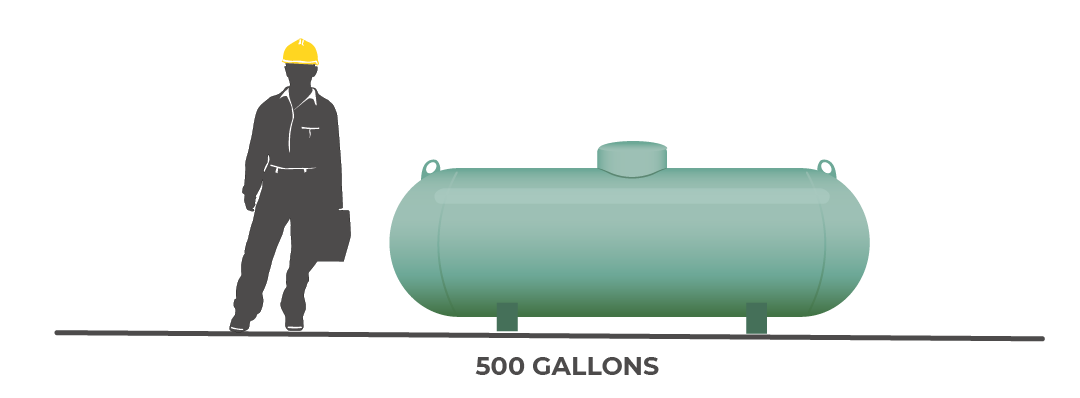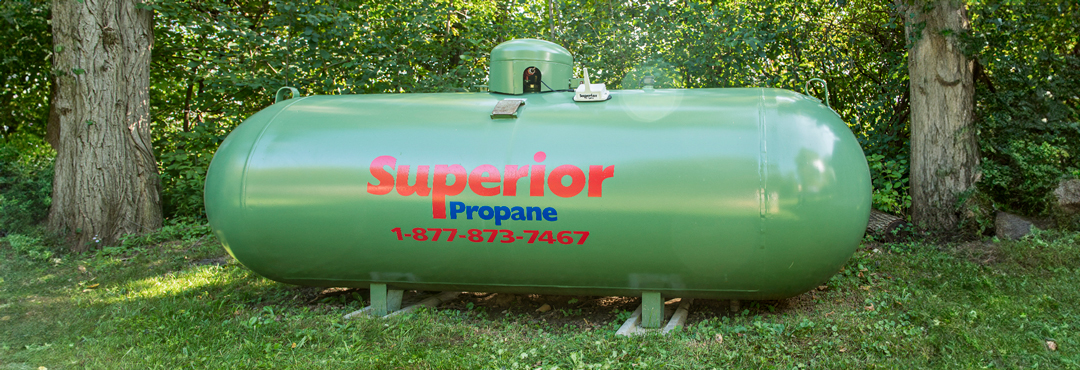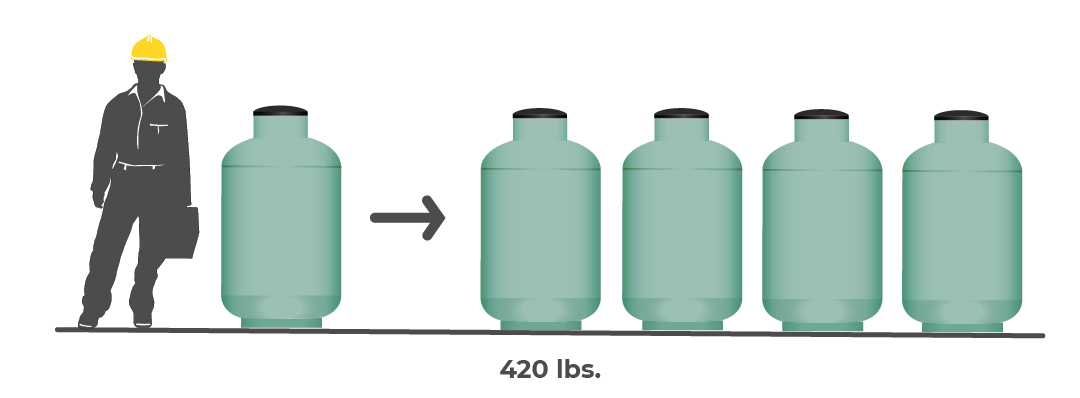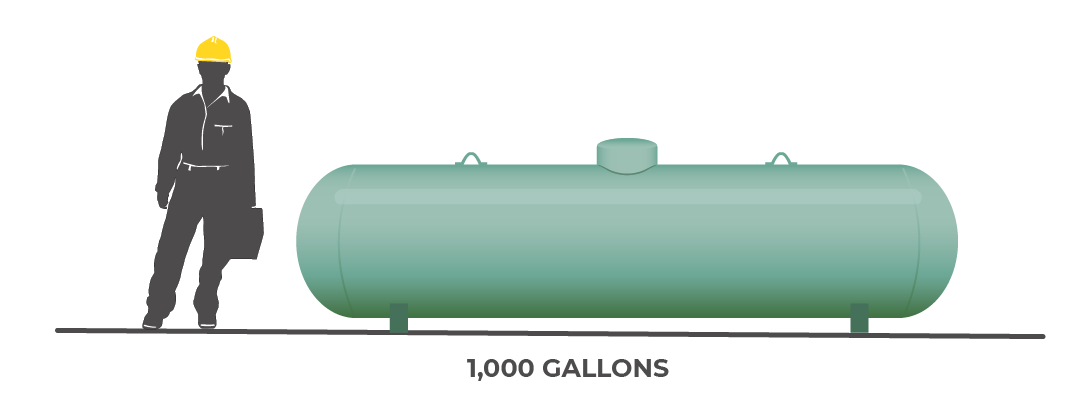WHAT SIZE PROPANE TANK DO I REALLY NEED?
Propane is a very versatile, efficient and cost-effective fuel that can be used for multiple applications in your home. From home heat to powering appliances and providing energy to your entire home, propane can do it all. So what tank size is the most ideal one for your needs? Let’s explore different tank sizes and the most common uses.
Propane, also known as liquified petroleum gas (LP gas or LPG) is a very efficient and reliable fuel that can be transported and stored in its liquid form. This highly efficient fuel is stored inside propane tanks or cylinders for homes and businesses. But which is which and what tank size is the most ideal for your energy needs?
The size of your propane tank will depend on a few factors such as the size of your home, the number of household occupants and how many appliances use propane to name a few. Your location can also play a role when selecting the right propane tank size. If you’re located in a region of Canada that experiences colder climates and more extreme temperatures, you might need a larger tank than those in locations with milder weather.
Propane tank sizes are usually referred to by the volume of liquid they hold. It's also important to note that LPG tanks are filled to a maximum of 80% of their capacity to allow for the natural expansion of liquid propane that occurs with a change in temperature. Therefore, a 500-gallon tank will typically hold approximately 400 gallons or 1,500 litres of liquid propane.
Check the following guide for the most common tank sizes and their uses so you can have a better idea about the tank size that suits your energy needs. Keep in mind, once you become a Superior Propane customer, one of our licensed technicians will perform an assessment of your property and energy needs, and recommend the most ideal tank size to satisfy them.
Learn more about the most common LP tank sizes used to store propane for homes and small and medium sized businesses below. Click here to learn about larger tanks for industrial applications.
Propane Cylinders:
Also known as vertical propane tanks, these types of tanks are a great choice when there are space concerns, as these tanks occupy very little surface space and can be placed directly against property walls and other space-limited areas.
420 lb. cylinder:
With a capacity of up to 372 L or 123 gallons of propane per cylinder and our smallest permanently installed tank option, these cylinders are a go-to choice for properties with spatial limitations, especially recommended when larger tanks are not feasible due to space constraints.
To compare, this size is similar in shape but significantly larger than a barbecue tank, which typically takes up to 20 lbs. of propane. Tall and round, it offers the flexibility of connecting together with up to three additional cylinders if you need more fuel but don't have the space for a larger tank. It's a real space saver and can be installed right against a building wall. Learn more about 420 lb. propane cylinders.
Most common uses of 420 lb. propane cylinders:
420 lb. cylinders are often manifolded together, up to four in total, with the most typical amount being two or three cylinders. When two or less are used, these cylinders can be used to power back up generators, heat specific areas or power specific appliances. While versatile for a myriad of uses ranging from water heaters, fireplaces, and other appliances to home heat, these cylinders can heat and power entire homes or businesses and multiple appliances when manifolded together, the same way a larger tank would. Propane cylinders can be easily installed right against a building wall.
Propane Tanks:
Also known as horizontal propane tanks or torpedo propane tanks, these vessels are more often used for residential and commercial applications if space is not an issue, since they can hold more propane than cylinders. Torpedo tanks can come in multiple sizes, with the two most common residential sizes being 500-gallon tanks and 1,000-gallon tanks.

500-Gallon propane tank:
Also known as 500 USWG tanks, this is one of the propane tank sizes most commonly used for residential and small commercial heating among other uses. It has a larger capacity but takes up more space, as it's almost 10 feet in length and must be installed at least 10 feet from any building or property line. They are approximately 3'10" High, 9'10" Long and have a Diameter of 38".
Most common uses of 500-Gallon Propane Tanks:
500-Gallon tanks at maximum capacity store more than enough fuel to make propane the powerhouse of the property, to efficiently and effectively heat up an entire home, or to be used for power generation, powering appliances like stoves and water heaters, pools, fireplaces and more.
1,000-gallon tank:
1,000 gallon propane tanks are more commonly used in commercial and agricultural applications, since they hold a larger volume of propane than what is typically required for the average household. However, large homes relying solely on propane and located in remote or difficult to reach areas in the winter may benefit from this size for the extra storage it offers. Spanning almost 16 feet in length, this tank must be installed at least 10 feet from any building and 10 feet from any property line. They are approximately 4'4" High, 15'11" Long and have a Diameter of 41".
Learn what your ideal propane tank size is here, or contact us at 1-87SUPERIOR (1-877-873-7467) for expert advice when choosing the right propane tank to suit your energy needs.
-
How many litres of propane does a propane tank or cylinder hold?
The capacity of a propane tank or cylinder varies by its size, with all tanks typically filled to 80% of their maximum capacity to allow for propane expansion. Here’s a breakdown by tank size:
• A 420 lb. propane cylinder can hold up to 372 litres. When these cylinders are manifolded together (up to 4 units), they can provide a total capacity of 1,488 litres.
• A 500-gallon propane tank can store up to 1,514 litres.
• A 1000-gallon propane tank has a capacity of up to 3,028 litres.
This 80% fill rule ensures safety and efficiency across all tank sizes. -
How many propane cylinders can be connected?
For propane storage, the number of cylinders or tanks that can be connected varies based on the configuration and space available:
For 420 lb. cylinders, it's common to manifold up to four units together, particularly when space constraints prevent the use of a larger tank. The typical installation involves two or three propane cylinders connected together.
-
Can I have multiple large propane tanks?Larger tanks, such as 500-gallon and 1,000-gallon, are usually installed individually due to their substantial capacity, but multiple tanks can be linked if higher volume is necessary, adhering to safety regulations and space considerations. However, for industrial applications that require more propane, the Superior Propane team evaluates the energy requirements, offering solutions including multiple larger tanks or higher-capacity individual tanks, from 2,000-gallon to 10,000-gallon tanks to meet the demand and satisfy the business needs.
-
How long does a 420 lb. cylinder of propane usually last?The duration of a 420 lb. propane cylinder varies based on several factors, including the size of your home and the number of appliances relying on propane. Typically, these tanks meet the common residential requirements, such as heating and running household appliances. A single 420 lb. cylinder can adequately heat a particular room or area of a home. For larger spaces or more extensive needs, like heating and powering an entire home or business, up to four manifolded 420 lb. cylinders may be utilized, especially in situations where installing a bigger tank is not feasible. Remember, the actual longevity of the tank depends on your specific usage and energy demands.
-
How long does a 500-gallon tank of propane usually last?The length of time a 500-gallon propane tank lasts depends on the size of your home, how many appliances run on propane, your indoor temperature setting if using as a main heat source, and outdoor temperatures to name a few factors. For example, a 500-gallon tank can provide enough propane for an average-sized home's heating, cooking, and hot water needs for several months. It's ideal for residential properties with moderate to high propane usage. The exact duration will depend on factors like the efficiency of appliances, the frequency of use, and the home's size, as well as location, as colder climates can increase consumption when propane is used for heating.
-
How long does a 1000-gallon tank of propane usually last?
A 1000-gallon propane tank provides space heating, cooking, hot water, pool heating, back up power and more for small businesses, commercial properties, or some large homes and can last up to 8 months or longer depending on applications and consumption patterns. This tank size is best suited for businesses that require a significant amount of propane for heating large spaces or operating numerous propane-powered appliances.
-
Can I move my propane tank?
You should never attempt to move or relocate your propane tanks or cylinders; our licensed technicians will install your propane tank or cylinder in the safest and most adequate location to ensure they are working up to standard and according to local and provincial regulations. You should never attempt to move or manipulate any tanks or cylinders yourself. Learn more about adequate propane tank safety, and if you have any questions or concerns about your tank's location, do not hesitate to contact us for an assessment.
Contact Us to Make the Switch

OR
Call Us Now at
1-855-540-7295




